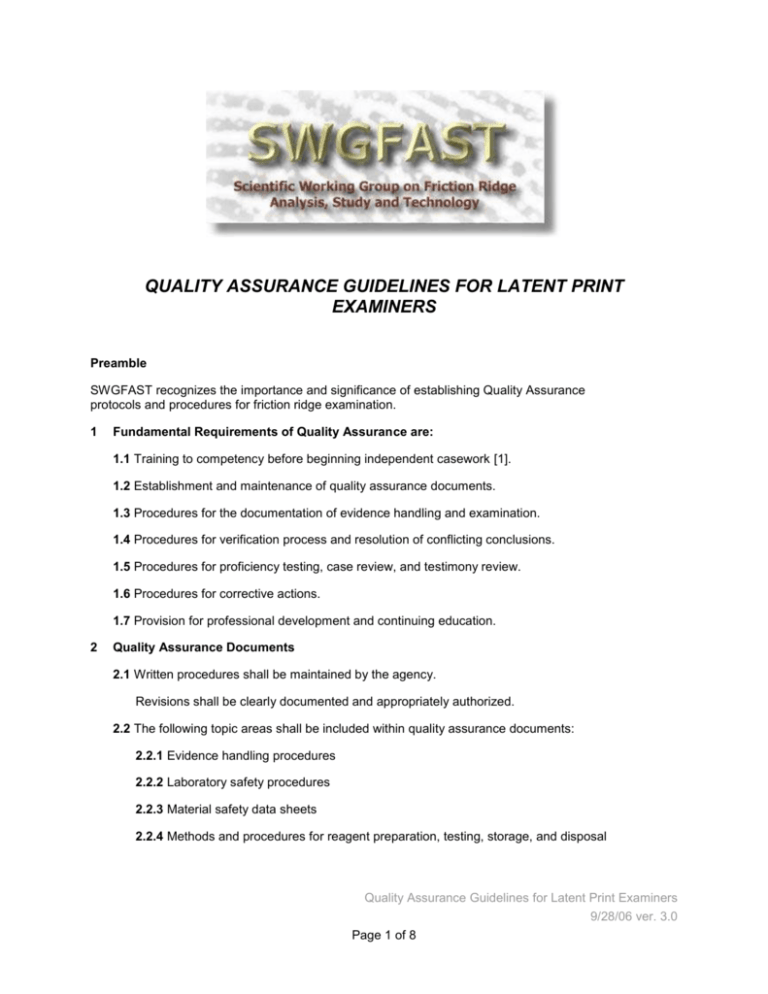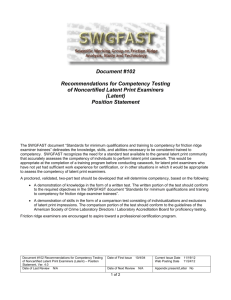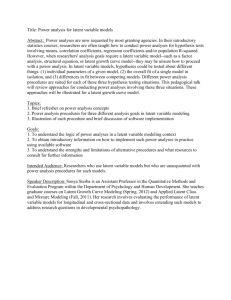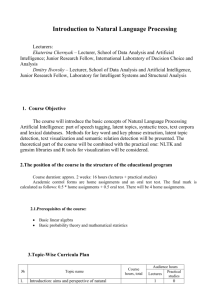Quality Assurance Guidelines for Latent Print Examiners
advertisement

QUALITY ASSURANCE GUIDELINES FOR LATENT PRINT EXAMINERS Preamble SWGFAST recognizes the importance and significance of establishing Quality Assurance protocols and procedures for friction ridge examination. 1 Fundamental Requirements of Quality Assurance are: 1.1 Training to competency before beginning independent casework [1]. 1.2 Establishment and maintenance of quality assurance documents. 1.3 Procedures for the documentation of evidence handling and examination. 1.4 Procedures for verification process and resolution of conflicting conclusions. 1.5 Procedures for proficiency testing, case review, and testimony review. 1.6 Procedures for corrective actions. 1.7 Provision for professional development and continuing education. 2 Quality Assurance Documents 2.1 Written procedures shall be maintained by the agency. Revisions shall be clearly documented and appropriately authorized. 2.2 The following topic areas shall be included within quality assurance documents: 2.2.1 Evidence handling procedures 2.2.2 Laboratory safety procedures 2.2.3 Material safety data sheets 2.2.4 Methods and procedures for reagent preparation, testing, storage, and disposal Quality Assurance Guidelines for Latent Print Examiners 9/28/06 ver. 3.0 Page 1 of 8 2.2.5 Methods and procedures for friction ridge impression development, image capture, and storage 2.2.6 Methods and procedures for friction ridge examination, including documentation and report writing 2.2.7 Methods and procedures for verification 2.2.8 Resolution of conflicting conclusions 2.2.9 Technical and administrative case review 2.2.10 Proficiency testing 2.2.11 Training and competency records 2.2.12 Equipment calibration and maintenance logs 2.2.13 Method validation records 2.2.14 Electronic fingerprint systems 2.2.15 Testimony review 2.2.16 Corrective action 3 Procedures for the Documentation of Evidence Handling and Examination 3.1 Written procedures shall be maintained by the agency. 3.2 Evidence handling procedures Evidence shall be collected, received, and stored to preserve the identity, integrity, condition, and security of the item. 3.2.1 A clear, well-documented chain of custody shall be maintained from the time that the evidence is collected or received until it is released. 3.2.2 Each agency shall prepare a written policy to ensure that evidence will be handled, processed, and preserved to protect against loss, contamination, or deterioration. 3.2.3 At the time of collection, latent print lifts, photographs/images shall be marked with unique case identifier and personal markings. When relevant, the information about the orientation and/or position of the latent print on the substrate through description and/or diagram(s) should also be included. At the time of examination, the latent print lifts, the photographs/images, or the case notes shall also include the following: 3.2.3.1 Unique case identifier 3.2.3.2 Date and initials or date and personal marking 3.2.3.3 Impression source (origin of the lift or photograph) Quality Assurance Guidelines for Latent Print Examiners 9/28/06 ver. 3.0 Page 2 of 8 3.2.3.4 Information to establish the scale If needed to perform a complete and proper ACE-V, it may be necessary to acquire additional information such as substrate, orientation/position of the impression, diagram(s), processing technique(s) used, and so forth. 3.3 Examination documentation and report writing Procedures shall be in place to ensure the case documentation is accurate and complete. These procedures are not intended to address evidence retention policies and procedures. 3.3.1 Examination documentation shall allow a competent examiner to evaluate what was done and to interpret the data, and shall include: 3.3.1.1 All examination activities 3.3.1.2 Latent print lifts, photographs/digital images, or legible copies of the latent prints of value 3.3.1.3 Known exemplars, Photographs/digital images or copies suitable for comparison of the known exemplars when an individualization has occurred 3.3.1.4 Annotations on original evidence, photographs/digital images, or copies that correlate to written notes 3.3.2 Report writing Reports shall contain the following: 3.3.2.1 Case identifier 3.3.2.2 Identity of examiner 3.3.2.3 Date of report 3.3.2.4 Item identifier and description of evidence 3.3.2.5 Statement of evidence examined 3.3.2.6 Results of latent print examination 4 Verification Process and Resolution of Conflicting Conclusions 4.1 Written procedures shall be maintained by the agency. 4.2 Terminology Full definitions of the following terms are in the SWGFAST Glossary and Friction Ridge Examination Methodology for Latent Print Examiners documents. Only the key elements of the examination protocol and associated conclusions are described. 4.2.1 Analysis Analysis includes the methodical assessment of a friction ridge impression to determine suitability for comparison. Quality Assurance Guidelines for Latent Print Examiners 9/28/06 ver. 3.0 Page 3 of 8 4.2.2 Comparison Comparison is the observation of friction ridge impressions for similarities or differences and includes a determination of the sequence and spatial relationship of friction ridge details. 4.2.3 Evaluation Evaluation is the formulation of a conclusion based upon analysis and comparison of friction ridge impressions. From the evaluation stage, the following conclusions can be drawn: 4.2.3.1 Individualization Individualization is the result of the comparison of two friction ridge impressions containing sufficient quality and quantity of friction ridge detail that is in agreement. Individualization occurs when a latent print examiner, trained to competency, determines that two friction ridge impressions originated from the same source, to the exclusion of all others. 4.2.3.2 Exclusion Exclusion is the result of the comparison of two friction ridge impressions containing sufficient quality and quantity of friction ridge detail that is not in agreement. Exclusion occurs when a latent print examiner, trained to competency, determines that two friction ridge impressions originated from different sources. 4.2.3.3 Inconclusive Inconclusive is the result when a latent print examiner, trained to competency, is unable to individualize or exclude the source of an impression. Inconclusive results shall not be construed as a statement of probability. Incomplete or unclear friction ridge impressions may result in the inability to reach either an individualization or exclusion decision. 4.2.4 Verification Verification is the confirmation of an examiner’s conclusion by another competent examiner. Blind verification is the confirmation of an examiner’s conclusion by another competent examiner who has no expectation or knowledge of the prior conclusion. 4.2.5 Conflicting conclusions Failure of the verification process to result in confirmation of a prior conclusion constitutes a conflicting conclusion. Quality Assurance Guidelines for Latent Print Examiners 9/28/06 ver. 3.0 Page 4 of 8 Three types of conflict can occur: 1) individualization versus exclusion, 2) individualization versus inconclusive, or 3) exclusion versus inconclusive. 4.3 Verification process 4.3.1 All individualizations shall be verified prior to being reported. 4.3.2 Exclusion or inconclusive results may be verified. 4.3.3 Agencies are encouraged to develop procedures for blind verification. These procedures may be applied to cases where there has been a single conclusion (individualization, exclusion, or inconclusive) to an individual or a complex latent print comparison. Blind verification may also be implemented through random case selection. 4.4 Resolution of conflicting conclusions When examiners have conflicting conclusions, a quality review shall be conducted. It is the responsibility of the agency to determine whether corrective action is appropriate. 4.4.1 Conflicting conclusions 4.4.1.1 Individualization versus exclusion If the quality review reveals that “exclusion” is the conclusion to be reported, then an erroneous individualization has been made. This is a serious error requiring corrective action as deemed appropriate. If the quality review reveals that “individualization” is the conclusion to be reported, then an erroneous exclusion has been made. Corrective action is required as deemed appropriate. 4.4.1.2 Inconclusive versus individualization / exclusion If the quality review reveals that either “individualization” or “exclusion” is the conclusion to be reported, then a failure to individualize or exclude has occurred. Corrective action may be required as deemed appropriate. If the quality review reveals that “inconclusive” is the conclusion to be reported, then the determination of individualization or exclusion is inappropriate. Corrective action may be required as deemed appropriate. 4.4.1.3 Verification of an erroneous conclusion is equal to having effected the original erroneous conclusion. 4.4.2 A quality review shall be documented and include: 4.4.2.1 A review of case documentation 4.4.2.2 Re-examination of the friction ridge impressions by the original examiners, independent internal examiner(s), or independent external examiner(s) 4.4.2.3 Determination of the conclusion to be reported Quality Assurance Guidelines for Latent Print Examiners 9/28/06 ver. 3.0 Page 5 of 8 4.4.2.4 Determination of the root cause(s) for the conflicting conclusions (individual or systemic) which may include: A review of training records of the examiner(s). A review of the training program. A review of prior work performance. 4.4.2.5 Determination of the seriousness of the conflicting conclusions. 4.4.2.6 Determination of corrective action if deemed appropriate. 5 Proficiency Tests, Case Review, and Testimony Review 5.1 Written procedures shall be maintained by the agency. 5.2 A proficiency test shall be completed by each latent print examiner annually [2]. 5.2.1 Proficiency tests may be purchased externally, developed in-house, or obtained from another agency. 5.2.2 The policies, procedures, and criteria for any corrective action taken as a result of a discrepancy shall be documented in writing. 5.2.3 At a minimum, proficiency test records should be consistent with the SWGFAST Guidelines for Latent Print Proficiency Testing Programs. 5.3 Technical case review Technical Reviews determine the quality of casework and ensure reliable results. These reviews concentrate on whether the appropriate tests and examinations have been performed and to support the results and conclusions reported, and whether sufficient supporting documentation is present. They also focus on whether the conclusions are consistent with the documentation and are within accepted practices. 5.3.1 Technical case reviews shall be conducted on a regular basis as defined in department policies and procedures. 5.3.2 A technical review will determine if: The appropriate examinations have been performed. The conclusions are consistent with the documented data and are within accepted practices. There is sufficient supporting documentation. Verifications have been completed and properly documented. The reported results are clear, concise, accurate, and complete. 5.3.3 A technical review by a competent latent print examiner may include a physical examination of the evidence or re-examination of all latent print comparisons. Quality Assurance Guidelines for Latent Print Examiners 9/28/06 ver. 3.0 Page 6 of 8 5.3.4 Technical reviews should be conducted by another competent latent print examiner. 5.3.5 The specific policies, procedures, and criteria for any corrective action taken as a result of a discrepancy in a technical case review should be clearly documented in writing. 5.4 Administrative review Administrative reviews determine the clerical accuracy of reports and case documentation. 5.4.1 Administrative reviews shall be conducted on all cases. 5.4.2 Administrative reviews shall be conducted by a supervisor or designee. 5.5 Testimony review Testimony review evaluates the performance of the examiner. 5.5.1 Testimony reviews should be conducted at least annually. 5.5.2 Testimony reviews shall be conducted for each examiner. 5.5.3 Testimony reviews may consist of any of the following: 5.5.3.1 Testimony Evaluation Survey Form 5.5.3.2 Verbal (or written) communication with court officials. 5.5.3.3 Review of written transcript, video, or audio recording of testimony. 5.5.3.4 Personal observation of testimony 5.5.4 If testimony is not given during the year, then that fact shall be documented. 6 Corrective Actions The agency is responsible for writing and enforcing policy to handle errors. When preparing written policy governing errors, a variety of corrective actions should be included. The corrective actions should be appropriate to the level of error, the skill level of the examiner, and the circumstances. 6.1 Corrective action shall be documented and include at least one of the following: 6.1.1 Immediate removal from latent print casework 6.1.2 A review of prior casework 6.1.3 Correction of training program deficiencies 6.1.4 Remedial training and competency testing 6.1.5 Counseling 6.1.6 A review of subsequent casework for a period of time Quality Assurance Guidelines for Latent Print Examiners 9/28/06 ver. 3.0 Page 7 of 8 Any action beyond corrective action is outside the scope of SWGFAST. SWGFAST does not construe corrective action to be disciplinary in nature. Disciplinary action is an agency-specific responsibility, and should be outlined in the written policies of the agency. 7 Professional Development and Continuing Education Professional development is important to broaden the examiner’s knowledge as well as experience. It requires a commitment by both the examiner and the agency. An agency should provide an opportunity for continuing education and have written policies supporting professional development. Examiner professional development may include discipline-specific activities such as: 7.1 Receiving specialized training 7.2 Attending educational seminars 7.3 Reading professional publications 7.4 Conducting and publishing research 7.5 Completing self-study programs 7.6 Instructing specialized classes or seminars 7.7 Membership and participation in professional organizations 7.8 Certification 7.9 Continuing formal education 8 References 1. SWGFAST, Training to Competency for Latent Print Examiners, 8/22/02, ver. 2.1. 2. SWGFAST, Guidelines for Latent Print Proficiency Testing Programs, 9/11/03, ver.1.0. Quality Assurance Guidelines for Latent Print Examiners 9/28/06 ver. 3.0 Page 8 of 8





